
No sé como se dice “artista manco” en inglés, pero yo me siento como una escritora manca. Me gustaría tanto poder escribir, pero no sé como inventarme cuentos ni cómo contar historias. Es más, cuando hay que relatar cualquier experiencia, le pido a alguien más que lo haga. No me vienen las palabras, no organizo las oraciones, me olvido de lo que quiero decir o me voy por tangentes muy largas.
Lo que sí puedo escribir, lo que me gusta escribir, son recuerdos. Mi papá tenía un libro de cuando era chico que se llamaba “Allá lejos y hace tiempo“. Estaba en la casa de City Bell, por alguna razón. Aunque por otra razón que no recuerdo nunca lo leí, siempre me gustó el título. Y viendo que me fui muy lejos de la tierra de mi niñez y han pasado tantos años, realmente describe a estas memorias.
Así que se me ocurrió que voy a tomar fotos que han sido escaneadas o fotografiadas y voy a escribir lo que se me venga. No serán cuentos o algún libro importante, pero bueno, es algo.
Empecemos con ésta, simplemente porque estaba hablando con mi hermano Junior (que se pronuncia Yunior, o “SHOO-nyor” para los que sólo hablan inglés, pero al que ahora lo llaman David, pronunciando “Deived” para los que sólo hablan español) sobre los muñecos que él tenía cuando era chico. Uno de ellos, un conejo de peluche rosa con pantalones de terciopelo color turquesa, llamado Davicito, era muy malo y siempre se peleaba con nuestras muñecas. Le pedí a mi hermano que buscara si tenía alguna foto, para presentárselo al resto de la familia que nació acá, en California, pero no encontró. En su lugar me envió esta foto, la que está arriba.
Estamos los tres hermanos, yo, Junior y Gabriela (el burro adelante para que no se espante) – que para ese entonces ya no se llamaba Iaia. No sé cuantos años tenía, yo diría 8 o 9. Junior tiene uno y medio menos y Gabriela uno y medio menos que él. Gabriela, para los que no saben, ya no está. Se nos murió hace ya varios años. Nunca me puedo acordar de cuantos. Y ni siquiera fue del riñón, lo que nos trajo a EEUU, pero esa es una historia para otro momento.
En la foto estamos en la cocina del departamento en La Plata donde crecimos. Estamos festejando el cumpleaños de los muñecos. No me parece que de algún muñeco en particular, sino de todos. Mi mamá, que nos daba cuerda con esto, hizo la torta. Seguramente la hizo de una mescla, pero el baño de 7 minutos (creo que se llama), tintado de rosa, lo hacía a mano. Todas nuestras tortas estaban cubiertas con ese baño. Y por lo tanto, la mayoría de nuestras tortas eran de colores. Años después, ya acá en Estados Unidos, colorizé una foto en blanco y negro para mi clase de fotografía, que mostraba a Gabriela soplando velitas. A la torta la hice color celeste o verde, y una de mis compañeras comentó de que las tortas no eran de esos colores. Bueno, las tortas de mi mamá, sí.
Viendo a los muñecos, me acuerdo bien de algunos y menos de otros. Recuerdo a las dos muñecas en mi mano derecha pero no también como para acordarme de sus nombres o siquiera si eran mías. La del medio, con el vestido amarillo, era Blanca Nieves. Mi mamá me había comprado a Blanca Nieves y los 7 enanitos creo que cuando estaba embarazada de mí. La muñeca duró más que los enanos. En mi otro brazo creo que tengo a Belinda, se ven algunos cabellos rubios y se me da que era ella. Belinda era una muñeca que hablaba y que mi abuelo Tito me había traído de Italia. Movía los labios y tenía un disco, creo que con canciones. Se rompió hace muchísimo pero todavía la tengo, escondida en un placard. Cuando las nenas eran chicas siempre me pedían que se las mostrar, aunque era está desnuda y ya no porta su trajecito rojo. Querían jugar con ella, pero nunca les dejé. Lo mismo con el Teddy Bear que no estuvo en esta fiesta y que tendré que describir cuando escriba sobre otra foto.
Delante de Belinda hay otra muñeca que no me acuerdo de donde salió pero que se ocurre era de mi mamá. No sé por qué. No era de las preferidas. No sé realmente como se sostienen los muñecos entre mi hermano y yo. Hay alguien escondido que los tiene en sus manos? Están sobre algún mueble?
Uno de ellos es el “mono”. Ya he escrito sobre el mono y en lugar de repetirme voy a poner un enlace a su historia en los comentarios (o, cuando copie esto a mi blog, acá mismo). Se me ocurre que la muñeca abajo del mono era Heidi. No se parece mucho a Heidi y ni siquiera me puedo acordar de como era la muñeca, pero tiene el pelo negro y el muñeco de pelo anaranjado cerca de ella, es Pedro – el amiguito de Heidi de la serie de dibujos animados de televisión. A los tres nos gustaba mucho a Heidi, pero especialmente a Gabriela. Los muñecos eran de ella. Me imagino que jugábamos las dos.
Heidi, para los que no sepan, fue un libro sobre una nena huérfana que va a vivir con su abuelo en las montañas de Suiza. Ahí conoce a Pedro, un niño pastor de cabras. Unos años después la llevan a la ciudad – Frankfurt (que queda en Alemania, a lo mejor Heidi no era suiza después de todo?), para ayudar a una niña rica paralítica. Finalmente vuelve a sus montañas.
Los japoneses hicieron una serie de dibujos animados sobre Heidi que fue muy popular en Argentina. Además de los muñecos teníamos álbumes de figuritas y cassettes con las canciones. Creo que la otra muñeca entre mi hermano y yo era de Gabriela, pero no me acuerda nada de ella.
Junior esta agarrando solamente a un muñeco: Martín. Lo tuvo desde muy chiquito, desde antes de que nos mudáramos al departamento cuando yo tenía cinco años y el casi cuatro. Martín era un muñeco de trapo, con una cabeza grande, un cuero chiquito y patas largas. Al contrario del conejo Davicito, Martín era bueno, no se peleaba con nadie. No me acuerdo que Junior jugara mucho con Martín, pero estaba ahí, en su pieza, sin molestar. La muñeca chiquitita que Gabriela tiene en la mano fue una de varias que había comprado mi mamá. Venían con trajes típicos, no me acuerdo si de otros países o tiempos o qué. Más tarde, cuando empezamos a jugar con Barbies (o realmente, con Sindies), eran sus hijas.
No sé por qué me parece que el nombre de la otra muñeca era María Eugenia. Pero también me parece que ese era el nombre de otra muñeca, una de pelo castaño que me habían regalado a mí, tenía ese nombre. Y claro, María Eugenia también fue el nombre de una compañera de escuela de Gabriela. En fin, estoy bastante segura de que esa muñera era de Gaby.
Qué más queda? El otro día le estaba contando a mi hija como mi mamá lavaba la ropa en el departamento. Entre la cocina y la ventana había una media pared que separaba la pileta de lavar ropa del fogón. Y al lado de la pileta estaba el lavaropas. Mamá tenía un aparato donde colgar ropa arriba de la pileta, pero además tenía un secarropas chiquito, ahí debajo de la ventana. Lo podés ver en la foto, atrás de Gabriela, cubierto de un mantel de…
Hace tantos años que no escribo en castellano que me he olvidado de montones de términos, en particular esos que no huzo mucho. Como se llaman esos manteles? Tengo la palabra en la punta de la lengua, pero no sale.
Cuando nos fuimos de EEUU, mi tía Gladys se llevó el secarropas a su casa. Lo volví a ver cuando la visité ya hace 15 años atrás. Lavamos ropa en su casa y lo usamos. El secarropas ya tenía más de 20 años para entonces. Justo hoy me compré un nuevo secarropas. Debe ser al menos del doble de tamaño y reemplaza a otro que creo que tenía menos de cinco años cuando se rompió. Todo tiempo pasado fue mejor, no?
La mesa de la cocina. Ahí es donde comíamos todos los días, desayuno, almuerzo, merienda y cena. Yo generalmente me sentaba al fin de la mesa, donde me pueden ver en la foto. Gabriela se sentaba en la otra punta, al lado de la heladera. Pero cuando Junior se sentaba en mi lugar, la miraba a Gabriela y ella se quejaba de que la miraba.
Tengo tantos, pero tantos recuerdos de esa cocina, donde pasábamos la mayor parte de nuestras horas. Ahora me doy cuenta de lo chiquita que era, de lo chiquito que era todo nuestro departamento, pero entonces me parecía grande – todo me parecía grande (excepto el departamento de mi tía Beatriz).
Voy a tener que escribir sobre la cocina más, sobre mis recuerdos. Ahí hacía los deberes, generalmente a la mañana antes de ir a la escuela. A veces es imposible creer que han pasado más de cuarenta años. Me parece que en cualquier momento vamos a volver a estar ahí los cinco, mamá, papá y nosotros tres. No puedo creer que esta historia se terminó, que ya no existe. Pero luego me doy cuenta de como aún los recuerdos se están yendo, se esfuman tal como las palabras. Todavía no recuerdo como se llama la tela de ese mantel.


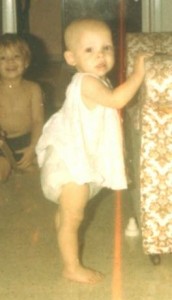
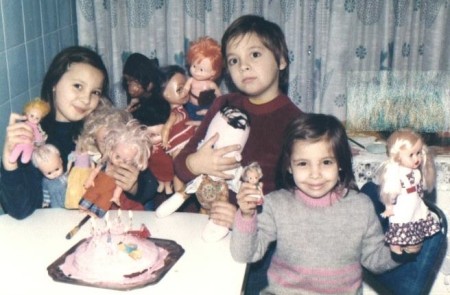
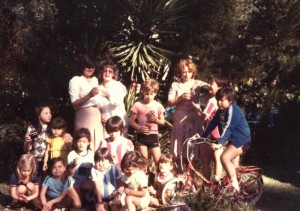
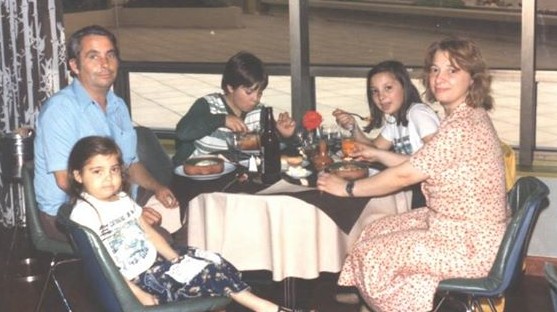
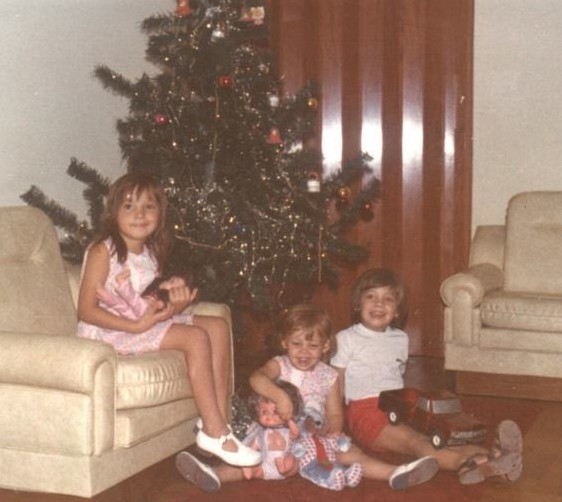
 Granny and Gladys, my grandmother and my aunt, were probably the most important people in my life growing up – and both remained so until their deaths.
Granny and Gladys, my grandmother and my aunt, were probably the most important people in my life growing up – and both remained so until their deaths.
Recent Comments